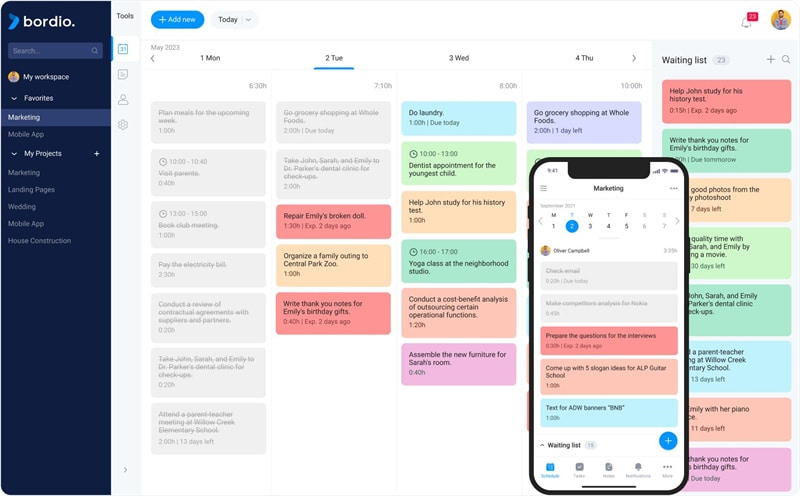
Every working day can be productive if you have a clear structure that you stick to. Here are some tips that you should follow to have a productive workday.
Whether you are self-employed or a valued employee of your company, everyone strives to ensure that every working day is productive. No one will pay you for your pretty face, so you need to prove your worth. This is easy to achieve when you complete all your assignments on time and it benefits your business or company.
However, not every day might be 100% productive. There are a huge number of distractions around that make us fall behind our work schedule. Some people are lazy by nature, and some try their best, but the level of productivity leaves much to be desired.
This happens when you don't have a clear structure for how your work day should go. When you clearly understand what tasks you need to do, and which ones are in priority, and at the same time you do not spend half a day communicating with colleagues, then you can achieve good results. It doesn’t take much time and effort to develop a clear structure, you just need to listen to wise advice and organize your working day so that you are satisfied with your work.
We will give you advice on how to establish a clear structure for your working day. Depending on the specifics of your work, you will be able to adapt your working day to suit all your needs.
Stick to your planner

In order not to wander around or remember at the last minute that you forgot to do something important, you should have a calendar that you will keep from day to day. Before the advent of all sorts of software and online tools, workers tried to keep paper calendars. However, they do not send any alerts or reminders of what needs to be done.
Fortunately, in the era of advanced tools, you can use the eschedule planner, which will become an indispensable tool in developing a clear structure for your working day. You can do the following without leaving your computer and phone:
- Create various projects and add new tasks;
- Set daily tasks in a couple of clicks;
- Set the duration of events or tasks so that you don't get behind schedule;
- Add reminders before each event or task;
- Keep a schedule for both work and personal life.
With this tool, you can reduce the amount of wasted time. All you have to do is get into the habit of reviewing your electronic planner every day and filling it with new tasks, events, and projects so that at the beginning of each new day you know what you need to do.
Set aside a certain amount of time for meetings

Everyone who meets with clients or organizes meetings with employees understands that such events can take a lot of time. During meetings, it's pretty easy to get off track and start talking about things that aren't relevant. Because of this, your productivity levels may drop and you will find that you have little time left for more important tasks.
Instead of mindlessly scheduling meetings that can last an unlimited amount of time, you should think ahead about the structure of what you need to discuss. If this is a meeting with a client, then determine how much time you need to discuss important issues. Don't talk about what your customers already know. Instead, mention only what you need to tell your client.
When arranging a meeting with employees, make a plan of the points you need to discuss and stick to your plan. At the end of each meeting, you can leave 10-15 minutes to hear feedback from employees and answer all their questions.
Determine the most productive period of your working day
All people are different and therefore not every person can start doing difficult tasks that require a lot of mental energy from the very beginning of the working day. You should analyze your activity and understand at what time of the day you can engage in priority tasks that require motivated thinking.
If you are most productive in the afternoon, try to schedule less energy-intensive tasks in the morning. For example, you can respond to all emails or deal with correspondence in the morning. Toward the end of the working day, try to leave those tasks that you can handle and do them with the highest quality.
Set priorities for the next business day
If you spend your morning filling out your electronic planner and putting together all the tasks for the current day, you will be wasting valuable time. The best solution is to prepare ahead of time. Half an hour before the end of the working day, you can open your digital calendar or electronic planner and see what you have done and what you haven't.
You can mark all completed tasks so that they no longer bother you. You can transfer tasks that have not yet been completed to the next day, and assign their priority and duration. Thus, when you come to work in the morning, you can open your scheduler, view the planned activity and start spending time usefully.
Leave time for breaks

If you want to achieve daily productivity, you can overdo it a little and plan your working days so that you don’t have free time to relax. Ultimately, this will not lead to anything good, because you will lead yourself to moral exhaustion and burnout. After each difficult task, you'd better set aside small breaks to de-stress your brain. This way you can rest and stock up on energy for the next task.
Don't forget that sitting at your desk all day long without snacking or taking a walk in the fresh air is not only bad for your emotional health but also for your physical health. Therefore, every day, leave time for a lunch break, as well as short breaks for going out into the fresh air.
Conclusion
It's pretty easy to make your workdays productive. You just need to establish a clear structure that you will adhere to daily. An electronic scheduler will help you in this endeavor, where you will create new tasks, projects, and events. You will understand what and when you need to do and not waste precious time on self-indulgence or procrastination.
In addition, do not forget about rest, because it is impossible to achieve productivity without rest for the brain.










